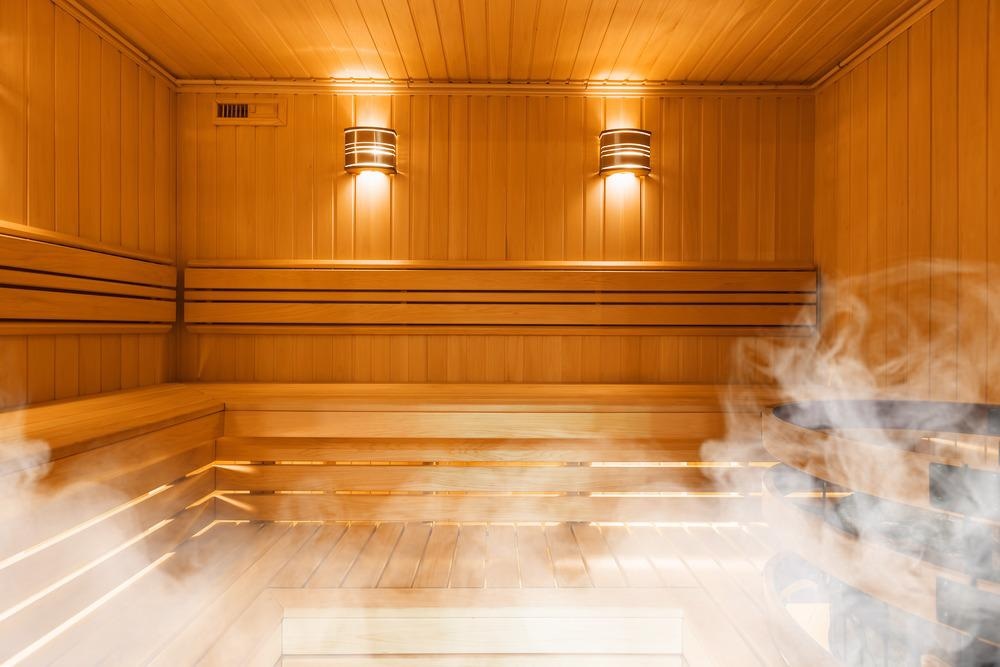Saunas are typically used for wellness, relaxation, and pleasure. Emerging evidence suggests that there are several health implications of saunas, which include a multitude f health benefits. Sauna bathing is associated with a reduction in the incidence of cardiovascular disease, including hypertension, as well as neurocognitive disorders and non-vascular conditions such as pulmonary disease, mental health conditions, and overall mortality. Sauna bathing has wider implications on the skin and rheumatological conditions.
These beneficial effects are attributed to the effect on circulatory, cardiovascular, and immune functions. It has been suggested that regular sauna bathing exit effects on the cardiovascular system via endothelium dependant dilation, reduced arterial stiffness, nervous system modulation, changes in circulating lipid's, and a reduction in blood pressure.
Sauna bathing is typically engaged for reasons of pleasure and relaxation. However, there are physiological changes associated with sauna bathing converting effects, on several systems and functions in the body. Moreover, sauna bathing regularly is believed to alleviate and prevent the risk of both acute and chronic disease conditions. Research from the past 12 years have accumulated evidence to suggest potential health benefits of sauna bathing and elucidate the biological pathways.

Image Credit: Mr. Tempter/Shutterstock.com
What is Sauna Bathing?
Sauna bathing is a form of heat therapy is characterized by exposure to a high temperature for a short amount of time. Modern-day saunas include the Finnish style sauna, Russian Banya, and Turkish style Hammam. They are differentiated according to their construction, source of heat, and humidity level.
Traditional Finnish saunas are the most widely studied of the three and involve short exposures, approximately 5 to 20 minutes, at temperatures that range between 80 and 100°C. The air is dry, with humidity between 10-20%, which is interspersed with periods of humidity produced by throwing water over heated rocks. An alternative version of the Finnish sauna which has grown in popularity includes the infrared sauna cabin. These are generally at lower temperatures (45–60°C) but include a similar exposure time. Saunas are also characterized by interspersed cooling-off periods and rehydration with fluid.
Saunas continue to grow in popularity owing to the growing belief that lifestyle interventions on necessary to enhance health and Wellness. This is particularly true in populations that experienced difficulty exercising.
The Effects of Sauna Bathing on Vascular Parameters
Sauna Bathing is thought to produce a similar effect to moderate or high-intensity physical exercise. Two recent experimental studies conducted in 100 men and women who had at least one cardiovascular risk factor demonstrated reductions in the systolic and diastolic blood pressures following a 30-minute session. In addition, sauna bathing led to beneficial changes in arterial stiffness as measured by pulse wave velocity.
In a study that examined the effects of sauna alone as an intervention compared to exercise and sauna combination; the results of this study demonstrated that both exercise and sauna bathing presented a form of nonpharmacological intervention to reduce systolic and mean blood pressure in patients with untreated hypertension.
Several key prospective studies that have assessed the association of sauna bathing with acute and chronic disease conditions have demonstrated that sauna bathing can reduce the risk of cardiovascular mortality, coronary heart disease mortality, sudden cardiac death incidents, ischemic and hemorrhagic stroke, all-cause mortality, respiratory and Alzheimer's disease, dementia, and pneumonia.
The Effect of Sauna Bathing on Cardiovascular Disease
Few studies have investigated the effects of regular sauna bathing on the long-term risk of developing cardiovascular disease. A prospective study of 2315 Finnish men followed over 20.7 years showed that there was an inverse correlation between duration of sauna bathing and risk of sudden cardiac death, coronary heart disease, cardiovascular disease, and all-cause mortality.
This study additionally accounted for confounding variables that may have influenced the risk of outcomes (these included low-density lipoprotein level, alcohol consumption, smoking frequency, body mass index, resting systolic blood pressure, resting heart rate, previous heart attack, presidents of type 2 diabetes, level of physical activity, and socioeconomic status). The result of this study suggests that excessive use of saunas can cause an increased risk of sudden cardiac death.
A second study of 1628 men over 15 years demonstrated that a single session per week resulted in a 62% decrease in risk of incident stroke and stroke subtypes (ischemic and hemorrhagic).
Sauna Bathing and Other Health Benefits
Sauna bathing has been linked to improved pain management and other symptoms associated with musculoskeletal disorders such as rheumatoid arthritis, fibromyalgia, and osteoarthritis. In addition, sauna baths have been shown to improve neurological pain such as tension-type headaches. A single study conducted in Japan suggested that thermal therapy can improve symptoms of depression, however, no such equivalent study has been conducted in the context of a sauna environment.
Sauna bathing is also thought to treat or prevent skin disease; however, there is very little robust evidence to support this. Among the research conducted, a study has demonstrated that sauna bathing can produce a positive effect in patients with psoriasis as it can facilitate the removal of hyperkeratotic scales.
An earlier study has demonstrated that Finnish saunas increase the hydration of the stratum conium, stabilizing the epidermal barrier function. The study also demonstrated that the skin also recovered faster from water loss and alterations to pH.
Saunas have been shown to produce a range of arbitrary effects, including improvements to health-related quality of life. Evidence for this comes from a cross-sectional analysis of a longitudinal cohort of 524 octogenarians; vitality, social and physical function, and general health was shown to be considerably greater among sauna users compared to two non-sauna users.

Image Credit: Adelaides/Shutterstock.com
What are the Mechanisms Relating Sauna Bathing to Positive Health Indicators?
The pathways implicated in the effects of sauna bathing, particularly on decreased risk of mortality and cardiovascular ill-health, include a reduction in systemic blood pressure. Concurrent with this, saunas are thought to improve endothelial function, and reduce oxidative stress and inflammation. Moreover, saunas have been shown to modulate the autonomic nervous system and produce positive changes in circulating vascular risk factors. These risk factors include natriuretic peptides which enhance sodium excretion.
Sauna bathing is also thought to produce hormonal changes alongside improving arterial stiffness and other parameters of artery health. Through their effects on these systems, sauna bathing is implicated in the pathophysiology of chronic disease outcomes namely cardiovascular disease, type 2 diabetes, and overall mortality.
Mechanistically, sauna bathing results in efficient blood flow to the skin, leading to increased cardiac output, and the concomitant decrease in blood flow to internal organs. The increased heat stimulates perspiration, reducing BP and increasing heart rate whilst maintaining cardiac stroke volume.
Saunas have been shown to induce a range of hormonal changes which includes an increase in the level of norepinephrine to a level comparable to those induced by maximal physical activity. Sauna therapy can also influence levels of cardiovascular biomarkers circulating in the blood. These include markers of glucose metabolism and insulin resistance alongside cardiac troponin T and inflammatory markers like interleukins and C reactive protein.
Sauna bathing has also been shown to boost the immune system; an effect elicited by reducing oxidative stress as oxidative processes have been implicated in the pathogenesis of disease conditions. However, evidence for the reduced oxidative stress effect has been conflicting. Nevertheless, sauna bathing has been shown to decrease the incidence of pulmonary conditions, which is in effect thought to be attributed to its direct action on the airways and lung tissue - namely improved ventilation and lung function alongside reduce congestion.
The Adverse Effects of Sauna Bathing
There is some evidence to suggest that the use of saunas can result in sudden death; However, incidences of sudden death have been, at least in part, due to alcohol consumption. This is thought to result from increased hypotension, cardiac complications, and the risk of traumatic events.
Moreover, sauna bathing could be contraindicated in patients who have recent heart and cardiovascular problems including myocardial infarction, severe aortic stenosis, ischemic or decompensated heart failure, and angina. Those with orthostatic hypotension or valvular disease are also discouraged from using saunas due to the risk of severely decreased blood pressure.
There is overwhelming evidence to suggest that sauna bathing has largely positive health impacts. It has been proven to elicit positive effects on the cardiovascular system, provided that it is used sensibly and within appropriate time limits. Although the exact mechanism through which saunas elicit these positive effects is unknown, several putative mechanistic pathways have been suggested.
Further research will be necessary to understand the pathophysiological mechanisms that describe the association between saunas and the multitude of health benefits they produce, as well as establish any causal relevance. Sauna bathing is particularly useful as an adjunct to exercise, particularly in populations that find barriers to exercise.
References:
- Laukkanen JA, Laukkanen T, Kunutsor SK. (2018) Cardiovascular and Other Health Benefits of Sauna Bathing: A Review of the Evidence. Mayo Clin Proc. doi:10.1016/j.mayocp.2018.04.008.
- Hussain J, Cohen M. (2018) Clinical Effects of Regular Dry Sauna Bathing: A Systematic Review. Evid Based Complement Alternat Med. doi:10.1155/2018/1857413.
Further Reading
Last Updated: Jan 18, 2022